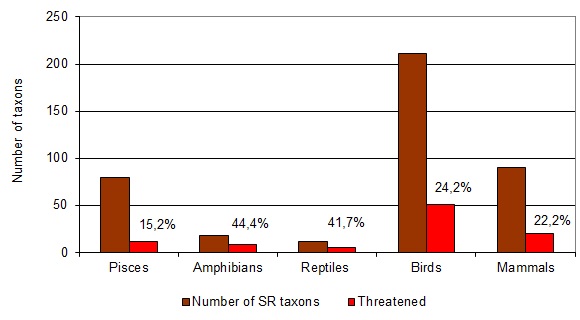Print
PDF
Endangerment of fauna species
Last update of indicator20.12.2021
Indicator definition
Endangerment of species represents proportion of species classified within categories of endangerment by IUCN (CR, EN a VU) to total number of known species. Situation with individual endangered fauna species in Slovakia has been compiled based on the recently published red list from 2001 (BALÁŽ, MARHOLD, URBAN A KOL. 2001). In 2005, red lists of molluscs and Orthoptera were updated, in 2008 fishes and in 2013 birds also.
Key messages
As to date, more than 28 thousand animal species have been documented in Slovakia with their level of endangerment becoming more and more significant. In case of all animals, the critical requirement is to ensure protection of their habitats – sufficiently large and preserved territories where the animals can live on their own and reproduce.
In the 90-ties, red lists that were valid at that time contained 466 endangered species of invertebrates and 153 species of vertebrates.
Red lists that are effective today were published in 2001 (only red lists of molluscs and Orthoptera were updated later in 2005, while red lists of fishes were updated in 2008 and birds in 2013). According to these lists, 1 636 species of invertebrates (6.6 %) and 100 species of vertebrates (24.2 %) are endangered. The most threatened are cockroaches (44.4 %), Ephemers (34.2 %), Odonata (33.3 %) and also Mollusca and Aranea (to 30 %); in group of Vertebrates, the most threatened are Lampreys (100 %) and Amphibians with Reptiles (over 40 %). Increased numbers may not mean an increased threat to animals, as they rather point to the fact that the species are better documented and subsequently added to the lists.
Red lists that are effective today were published in 2001 (only red lists of molluscs and Orthoptera were updated later in 2005, while red lists of fishes were updated in 2008 and birds in 2013). According to these lists, 1 636 species of invertebrates (6.6 %) and 100 species of vertebrates (24.2 %) are endangered. The most threatened are cockroaches (44.4 %), Ephemers (34.2 %), Odonata (33.3 %) and also Mollusca and Aranea (to 30 %); in group of Vertebrates, the most threatened are Lampreys (100 %) and Amphibians with Reptiles (over 40 %). Increased numbers may not mean an increased threat to animals, as they rather point to the fact that the species are better documented and subsequently added to the lists.
Summary assessment
Number of vertebrate species – total and threatened

Source: SNC SR
Explanations:
Pisces - including lampreys;
Birds - only nesting (total 211 species of nesting birds were assessed);
Data in % indicates the proportion of threatened species in the total number of species;
Threatened - only species included in IUCN categories CR, EN and VU
IUCN categories: CR - critically endangered taxon, EN - endangered taxon, VU - vulnerable taxon.
Source table
Number of vertebrate species – total and threatened
Source: SNC SR
| Number of SR taxons | Threatened | Threatened (%) | |
| Pisces | 79 | 12 | 15.2 |
| Amphibians | 18 | 8 | 44.4 |
| Reptiles | 12 | 5 | 41.7 |
| Birds | 211 | 51 | 24.2 |
| Mammals | 90 | 20 | 22.2 |
International comparison
The OECD Green Growth database contains selected indicators for monitoring progress towards green growth to support policy making and inform the public at large. The database provides a synthesis of data and indicators available across a wide range of domains. The sources of the underlying data used to populate the Green Growth Indicators, as presented here, include a range of OECD databases and, in some cases, external data sources. The database covers OECD member countries, accession countries and selected non-OECD countries (including the BRIICS economies - Brazil, Russian Federation, India, Indonesia, China and South Africa).